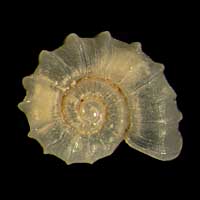|
< Previous family introduction |
|
|||||
 |
Family Skeneidae
|
|||||
|
The Skeneidae is a family with minute, umbilicate shells usually 1-3 mm in size. It is of uncertain placement and extent, and has been a repository for assorted genera and species of small shells difficult to place in other families. Some authors treat it a a separate family, others as a subfamily of the Turbinidae, while others distribute the included genera into other families. The animals are related to the Trochidae but differ in the structure of the ctenidium and in the arrangement of the tentacles, and the shells differ by lacking an inner nacreous layer. For convenience it is treated here as a family, while recognising that the placement and content are not yet determined. Shell form and sculpture is very variable in the Skeneidae, from planispiral to turbiniform, and from smooth to strongly sculptured with axial and spiral ornamentation. The unifying features are a thin and uncoloured shell, with a narrow to wide umbilicus often sculptured with spiral ribs within, a circular aperture and a multispiral corneous operculum. The protoconch appears smooth under the light microscope, with a well-defined junction to the teleoconch. The habitats of the Australian species are poorly known. They are so small that specimens are usually sorted from beach washup, algae and rock washings or dredge samples, without the actual detail of habitat being clear. There is no documentation of gut contents, diet or feeding behaviour. In contrast to the lack of knowledge of most members of the family, a group of deep water species found on waterlogged wood was closely investigated by Marshall (1988). Wood from depths down to 1100 m from New Zealand and New South Wales was found to provide a habitat, in the holes produced by boring bivalves, for a suite of minute molluscs, including 18 new species of Skeneidae. Three of these species occur in NSW waters and are included here. The NSW species of Skeneidae were first revised by Laseron (1954), as part of a heterogeneous grouping that he referred to as Liotiidae. Over the following 55 years, observations on external morphology and anatomy of the animals has lead to the distribution of the species he treated into the Turbinidae, Vitrinellidae, Cornirostridae, Trochidae, Orbitestillidae, and Omalogyridae, with 24 taxa allocated to Skeneidae. Laseron based his work entirely on shell morphology, had a limited range of specimens, and apparently did not have access to type specimens from Tasmania, Victoria, and South Australia. Consequently he assigned names to species which had already been named, particularly in the genera Brookula and Liotella. Of the seven species of Brookula he named, only one name is not in synonymy, and in Liotella none of his names have survived. These synonyms are introduced as new in this work, but most of them were recognised by Dr. W.F. Ponder who commenced, but did not publish, a revision of the family in the 1980s. There are 24 species referred to the family here. All of them are considered endemic to Australia, but may well be found to have wider distributions. Many are assigned distributions from NSW to South Australia, including Tasmania, based on the collections of the Australian Museum and the publication of May (1923) cataloguing the Tasmanian fauna, and of Cotton (1959) cataloguing the South Australian fauna. With further research the ranges of at least some will probably be found to extend from southern Queensland to south-western WA, as is the case for many other molluscs that occur in NSW. Family References Only the most important references for species identification are given here. Other references cited in the text are listed in "References", accessible from the "Table of Contents" page.
Coverage All of the species from NSW that could be positively identified and referred to this family have been included here. The Australian Museum collection holds many specimens that may be undescribed species, and others that may be forms of named species. However, the common species from the intertidal zone and from shallow water have been named and are covered here, allowing perhaps 90% of specimens collected in these zones to be identified. Identification Notes With the exception of Crossea concinna, shells in this family are less than 3 mm in size. They vary widely in form, but have in common a narrow to wide umbilicus, circular aperture and are uncoloured. Shells that are similar in these characters are found in the Trochidae, but are generally larger. Small species generally similar in form are found in the Eatoniellidae, Vitrinellidae, Rissoidae, Assimineidae, Elachisinidae, Cornirostridae and Orbitestellidae.
|